University Assignment: Critique of Project Measurement Criteria Paper
VerifiedAdded on 2022/09/18
|6
|1503
|36
Report
AI Summary
This report provides a critique of the research paper "A qualitative re-construction of project measurement criteria" by Ojiako, Johansen, and Greenwood, published in Industrial Management & Data Systems in 2008. The paper investigates project failures in industries like IS/IT and construction, focusing on qualitative approaches to reconstruct project performance measurement. The critique summarizes the paper's core argument, which challenges traditional metrics like time, cost, and quality, proposing alternative criteria for assessing project success and failure. The report analyzes the research methodology, including the use of grounded theory, interviews with project management professionals, and non-random purposive sampling. The critique highlights the paper's key findings, such as the importance of project complexity and the need for proper project planning and team relationships. The critique also offers recommendations for further research, particularly emphasizing the need for more examples of successful projects and their critical success factors. The report concludes by acknowledging the paper's contribution to understanding project measurement criteria and its implications for project management practice.
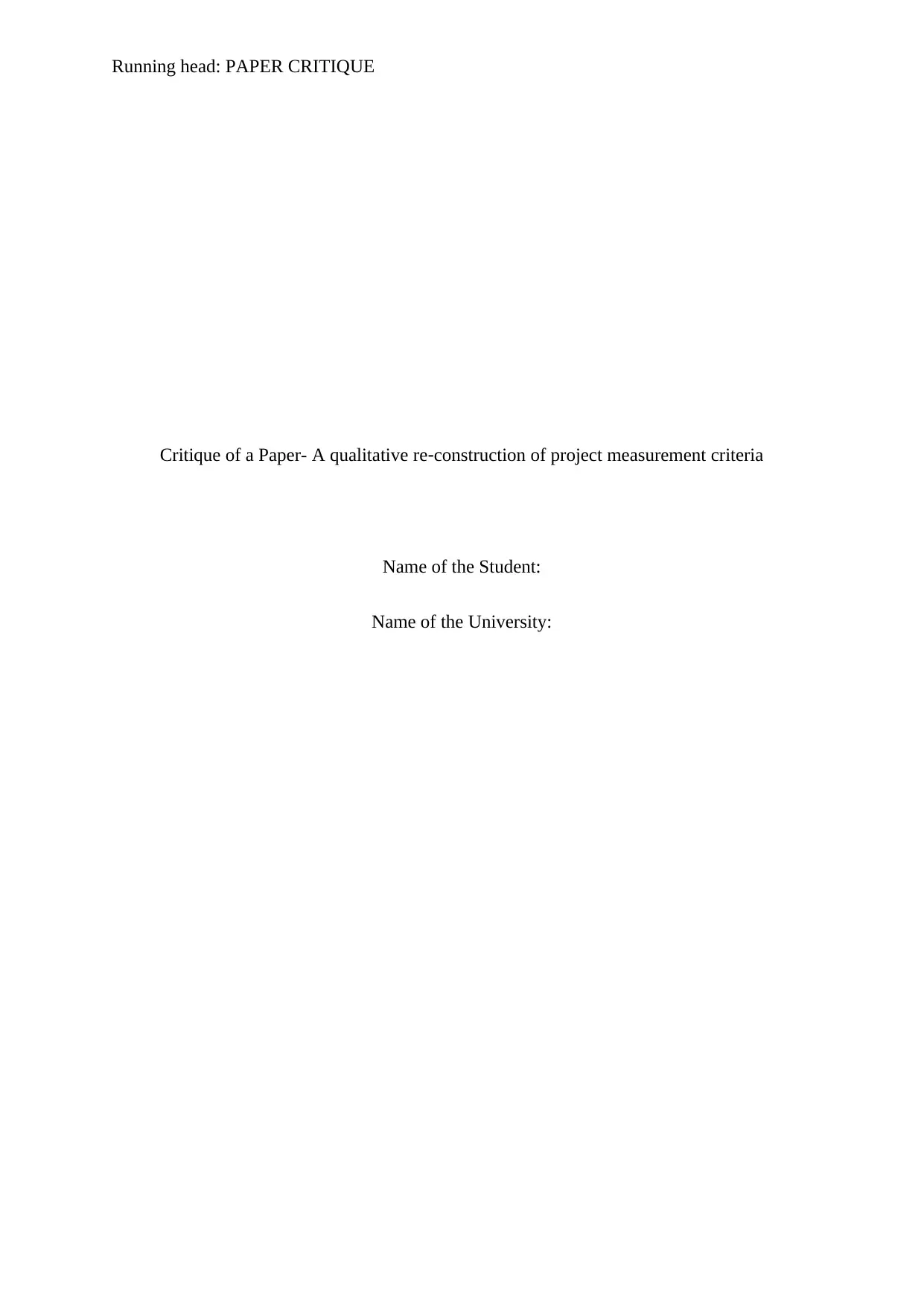
Running head: PAPER CRITIQUE
Critique of a Paper- A qualitative re‐construction of project measurement criteria
Name of the Student:
Name of the University:
Critique of a Paper- A qualitative re‐construction of project measurement criteria
Name of the Student:
Name of the University:
Paraphrase This Document
Need a fresh take? Get an instant paraphrase of this document with our AI Paraphraser
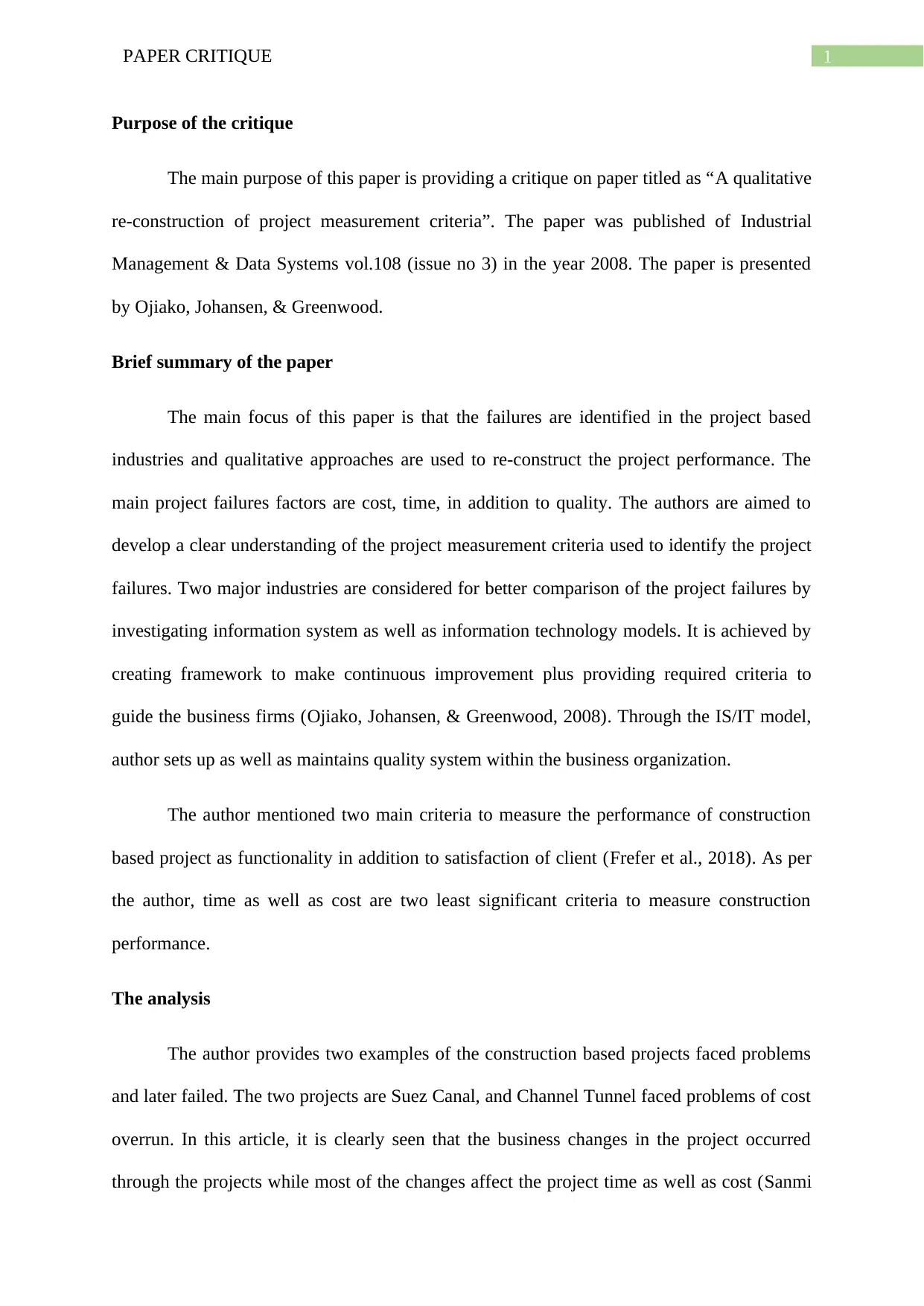
1PAPER CRITIQUE
Purpose of the critique
The main purpose of this paper is providing a critique on paper titled as “A qualitative
re-construction of project measurement criteria”. The paper was published of Industrial
Management & Data Systems vol.108 (issue no 3) in the year 2008. The paper is presented
by Ojiako, Johansen, & Greenwood.
Brief summary of the paper
The main focus of this paper is that the failures are identified in the project based
industries and qualitative approaches are used to re-construct the project performance. The
main project failures factors are cost, time, in addition to quality. The authors are aimed to
develop a clear understanding of the project measurement criteria used to identify the project
failures. Two major industries are considered for better comparison of the project failures by
investigating information system as well as information technology models. It is achieved by
creating framework to make continuous improvement plus providing required criteria to
guide the business firms (Ojiako, Johansen, & Greenwood, 2008). Through the IS/IT model,
author sets up as well as maintains quality system within the business organization.
The author mentioned two main criteria to measure the performance of construction
based project as functionality in addition to satisfaction of client (Frefer et al., 2018). As per
the author, time as well as cost are two least significant criteria to measure construction
performance.
The analysis
The author provides two examples of the construction based projects faced problems
and later failed. The two projects are Suez Canal, and Channel Tunnel faced problems of cost
overrun. In this article, it is clearly seen that the business changes in the project occurred
through the projects while most of the changes affect the project time as well as cost (Sanmi
Purpose of the critique
The main purpose of this paper is providing a critique on paper titled as “A qualitative
re-construction of project measurement criteria”. The paper was published of Industrial
Management & Data Systems vol.108 (issue no 3) in the year 2008. The paper is presented
by Ojiako, Johansen, & Greenwood.
Brief summary of the paper
The main focus of this paper is that the failures are identified in the project based
industries and qualitative approaches are used to re-construct the project performance. The
main project failures factors are cost, time, in addition to quality. The authors are aimed to
develop a clear understanding of the project measurement criteria used to identify the project
failures. Two major industries are considered for better comparison of the project failures by
investigating information system as well as information technology models. It is achieved by
creating framework to make continuous improvement plus providing required criteria to
guide the business firms (Ojiako, Johansen, & Greenwood, 2008). Through the IS/IT model,
author sets up as well as maintains quality system within the business organization.
The author mentioned two main criteria to measure the performance of construction
based project as functionality in addition to satisfaction of client (Frefer et al., 2018). As per
the author, time as well as cost are two least significant criteria to measure construction
performance.
The analysis
The author provides two examples of the construction based projects faced problems
and later failed. The two projects are Suez Canal, and Channel Tunnel faced problems of cost
overrun. In this article, it is clearly seen that the business changes in the project occurred
through the projects while most of the changes affect the project time as well as cost (Sanmi
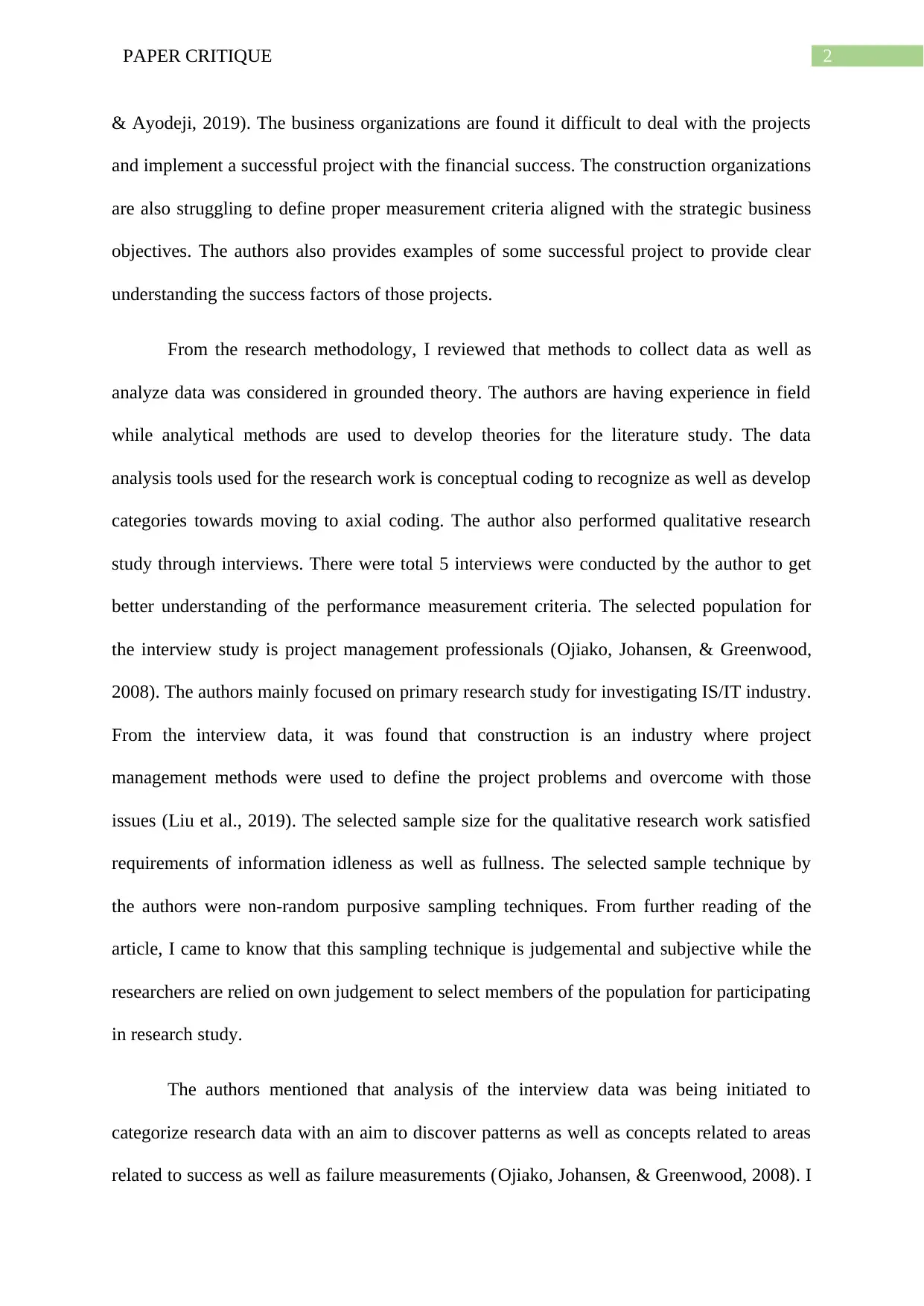
2PAPER CRITIQUE
& Ayodeji, 2019). The business organizations are found it difficult to deal with the projects
and implement a successful project with the financial success. The construction organizations
are also struggling to define proper measurement criteria aligned with the strategic business
objectives. The authors also provides examples of some successful project to provide clear
understanding the success factors of those projects.
From the research methodology, I reviewed that methods to collect data as well as
analyze data was considered in grounded theory. The authors are having experience in field
while analytical methods are used to develop theories for the literature study. The data
analysis tools used for the research work is conceptual coding to recognize as well as develop
categories towards moving to axial coding. The author also performed qualitative research
study through interviews. There were total 5 interviews were conducted by the author to get
better understanding of the performance measurement criteria. The selected population for
the interview study is project management professionals (Ojiako, Johansen, & Greenwood,
2008). The authors mainly focused on primary research study for investigating IS/IT industry.
From the interview data, it was found that construction is an industry where project
management methods were used to define the project problems and overcome with those
issues (Liu et al., 2019). The selected sample size for the qualitative research work satisfied
requirements of information idleness as well as fullness. The selected sample technique by
the authors were non-random purposive sampling techniques. From further reading of the
article, I came to know that this sampling technique is judgemental and subjective while the
researchers are relied on own judgement to select members of the population for participating
in research study.
The authors mentioned that analysis of the interview data was being initiated to
categorize research data with an aim to discover patterns as well as concepts related to areas
related to success as well as failure measurements (Ojiako, Johansen, & Greenwood, 2008). I
& Ayodeji, 2019). The business organizations are found it difficult to deal with the projects
and implement a successful project with the financial success. The construction organizations
are also struggling to define proper measurement criteria aligned with the strategic business
objectives. The authors also provides examples of some successful project to provide clear
understanding the success factors of those projects.
From the research methodology, I reviewed that methods to collect data as well as
analyze data was considered in grounded theory. The authors are having experience in field
while analytical methods are used to develop theories for the literature study. The data
analysis tools used for the research work is conceptual coding to recognize as well as develop
categories towards moving to axial coding. The author also performed qualitative research
study through interviews. There were total 5 interviews were conducted by the author to get
better understanding of the performance measurement criteria. The selected population for
the interview study is project management professionals (Ojiako, Johansen, & Greenwood,
2008). The authors mainly focused on primary research study for investigating IS/IT industry.
From the interview data, it was found that construction is an industry where project
management methods were used to define the project problems and overcome with those
issues (Liu et al., 2019). The selected sample size for the qualitative research work satisfied
requirements of information idleness as well as fullness. The selected sample technique by
the authors were non-random purposive sampling techniques. From further reading of the
article, I came to know that this sampling technique is judgemental and subjective while the
researchers are relied on own judgement to select members of the population for participating
in research study.
The authors mentioned that analysis of the interview data was being initiated to
categorize research data with an aim to discover patterns as well as concepts related to areas
related to success as well as failure measurements (Ojiako, Johansen, & Greenwood, 2008). I
⊘ This is a preview!⊘
Do you want full access?
Subscribe today to unlock all pages.

Trusted by 1+ million students worldwide
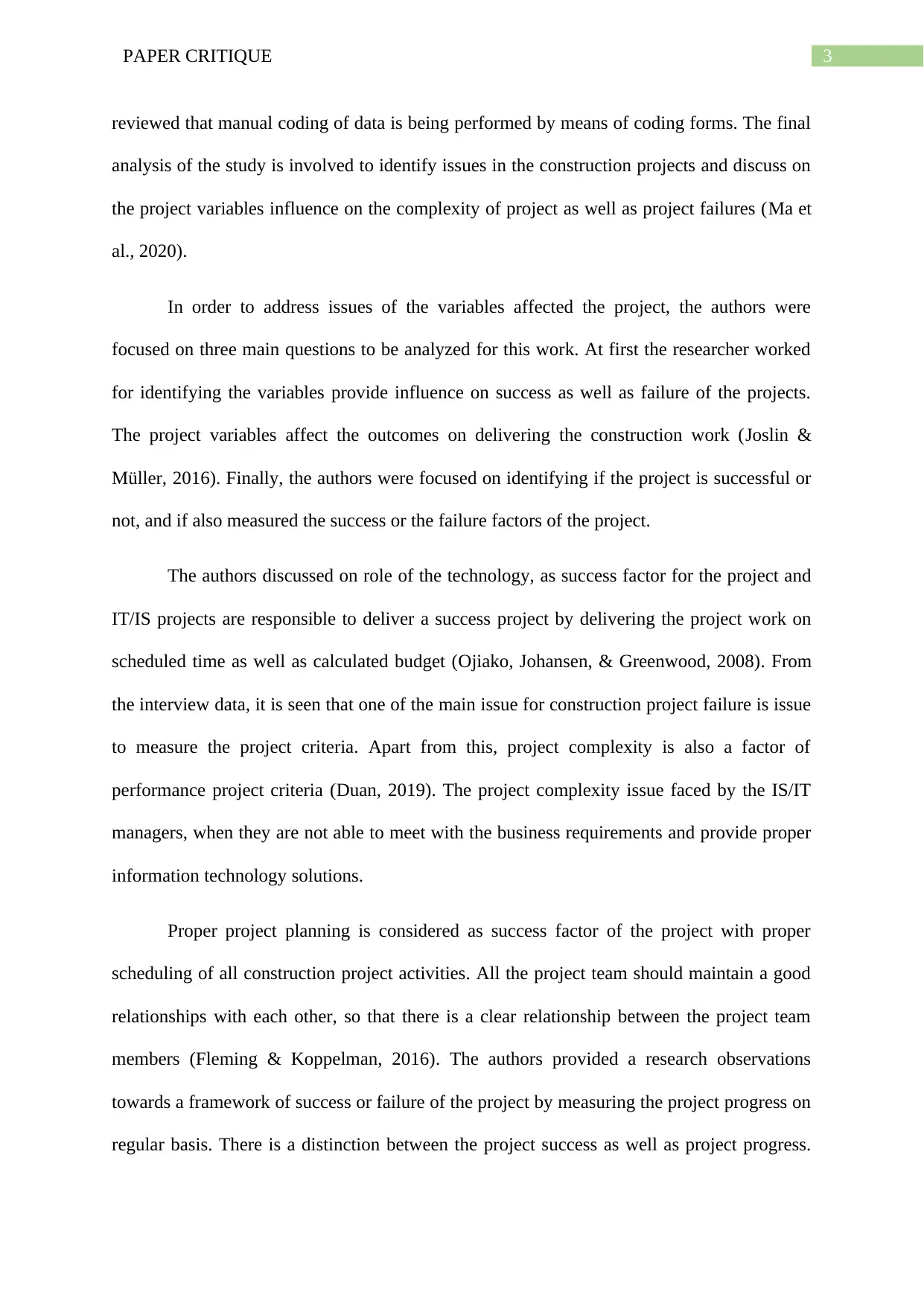
3PAPER CRITIQUE
reviewed that manual coding of data is being performed by means of coding forms. The final
analysis of the study is involved to identify issues in the construction projects and discuss on
the project variables influence on the complexity of project as well as project failures (Ma et
al., 2020).
In order to address issues of the variables affected the project, the authors were
focused on three main questions to be analyzed for this work. At first the researcher worked
for identifying the variables provide influence on success as well as failure of the projects.
The project variables affect the outcomes on delivering the construction work (Joslin &
Müller, 2016). Finally, the authors were focused on identifying if the project is successful or
not, and if also measured the success or the failure factors of the project.
The authors discussed on role of the technology, as success factor for the project and
IT/IS projects are responsible to deliver a success project by delivering the project work on
scheduled time as well as calculated budget (Ojiako, Johansen, & Greenwood, 2008). From
the interview data, it is seen that one of the main issue for construction project failure is issue
to measure the project criteria. Apart from this, project complexity is also a factor of
performance project criteria (Duan, 2019). The project complexity issue faced by the IS/IT
managers, when they are not able to meet with the business requirements and provide proper
information technology solutions.
Proper project planning is considered as success factor of the project with proper
scheduling of all construction project activities. All the project team should maintain a good
relationships with each other, so that there is a clear relationship between the project team
members (Fleming & Koppelman, 2016). The authors provided a research observations
towards a framework of success or failure of the project by measuring the project progress on
regular basis. There is a distinction between the project success as well as project progress.
reviewed that manual coding of data is being performed by means of coding forms. The final
analysis of the study is involved to identify issues in the construction projects and discuss on
the project variables influence on the complexity of project as well as project failures (Ma et
al., 2020).
In order to address issues of the variables affected the project, the authors were
focused on three main questions to be analyzed for this work. At first the researcher worked
for identifying the variables provide influence on success as well as failure of the projects.
The project variables affect the outcomes on delivering the construction work (Joslin &
Müller, 2016). Finally, the authors were focused on identifying if the project is successful or
not, and if also measured the success or the failure factors of the project.
The authors discussed on role of the technology, as success factor for the project and
IT/IS projects are responsible to deliver a success project by delivering the project work on
scheduled time as well as calculated budget (Ojiako, Johansen, & Greenwood, 2008). From
the interview data, it is seen that one of the main issue for construction project failure is issue
to measure the project criteria. Apart from this, project complexity is also a factor of
performance project criteria (Duan, 2019). The project complexity issue faced by the IS/IT
managers, when they are not able to meet with the business requirements and provide proper
information technology solutions.
Proper project planning is considered as success factor of the project with proper
scheduling of all construction project activities. All the project team should maintain a good
relationships with each other, so that there is a clear relationship between the project team
members (Fleming & Koppelman, 2016). The authors provided a research observations
towards a framework of success or failure of the project by measuring the project progress on
regular basis. There is a distinction between the project success as well as project progress.
Paraphrase This Document
Need a fresh take? Get an instant paraphrase of this document with our AI Paraphraser
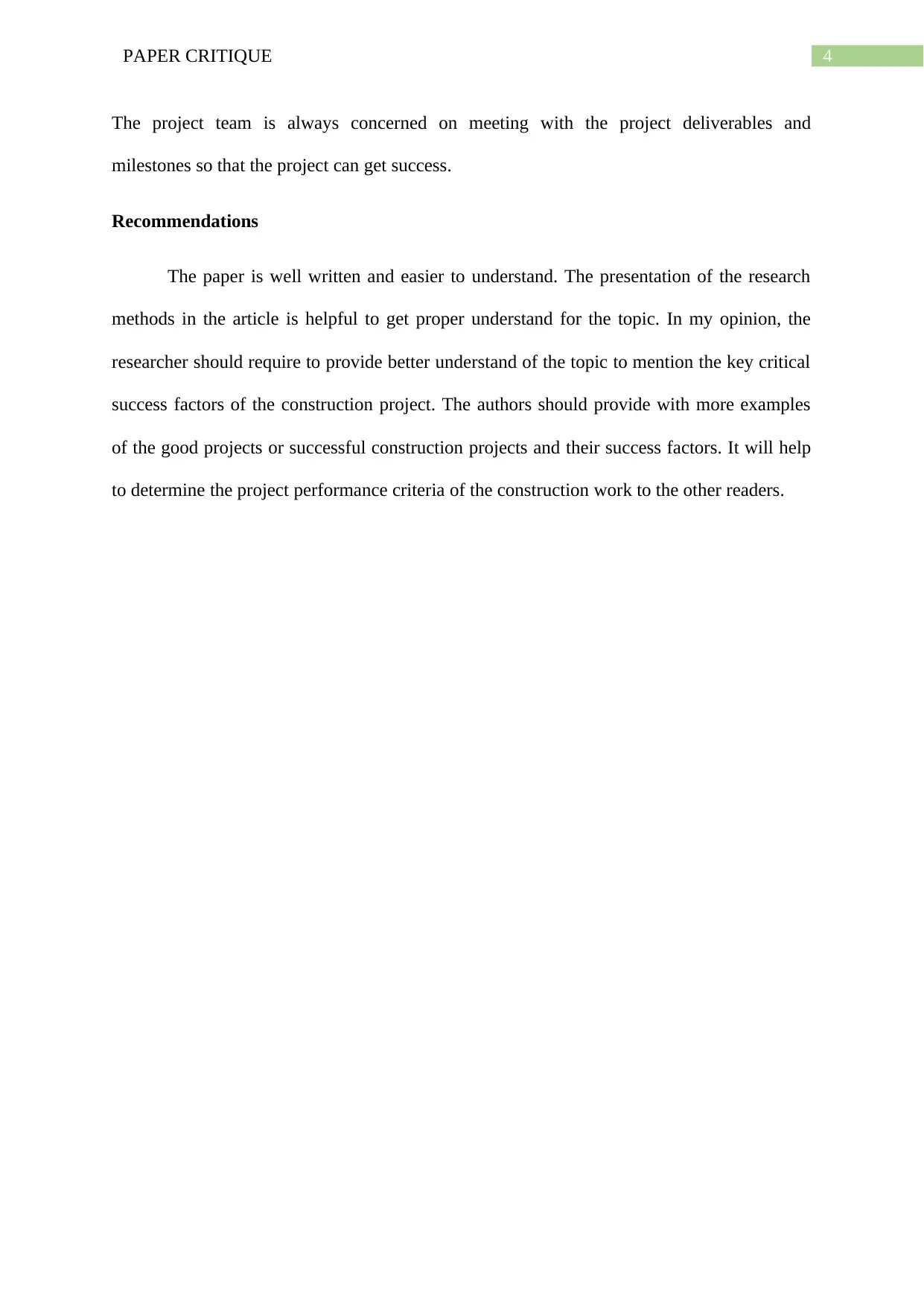
4PAPER CRITIQUE
The project team is always concerned on meeting with the project deliverables and
milestones so that the project can get success.
Recommendations
The paper is well written and easier to understand. The presentation of the research
methods in the article is helpful to get proper understand for the topic. In my opinion, the
researcher should require to provide better understand of the topic to mention the key critical
success factors of the construction project. The authors should provide with more examples
of the good projects or successful construction projects and their success factors. It will help
to determine the project performance criteria of the construction work to the other readers.
The project team is always concerned on meeting with the project deliverables and
milestones so that the project can get success.
Recommendations
The paper is well written and easier to understand. The presentation of the research
methods in the article is helpful to get proper understand for the topic. In my opinion, the
researcher should require to provide better understand of the topic to mention the key critical
success factors of the construction project. The authors should provide with more examples
of the good projects or successful construction projects and their success factors. It will help
to determine the project performance criteria of the construction work to the other readers.
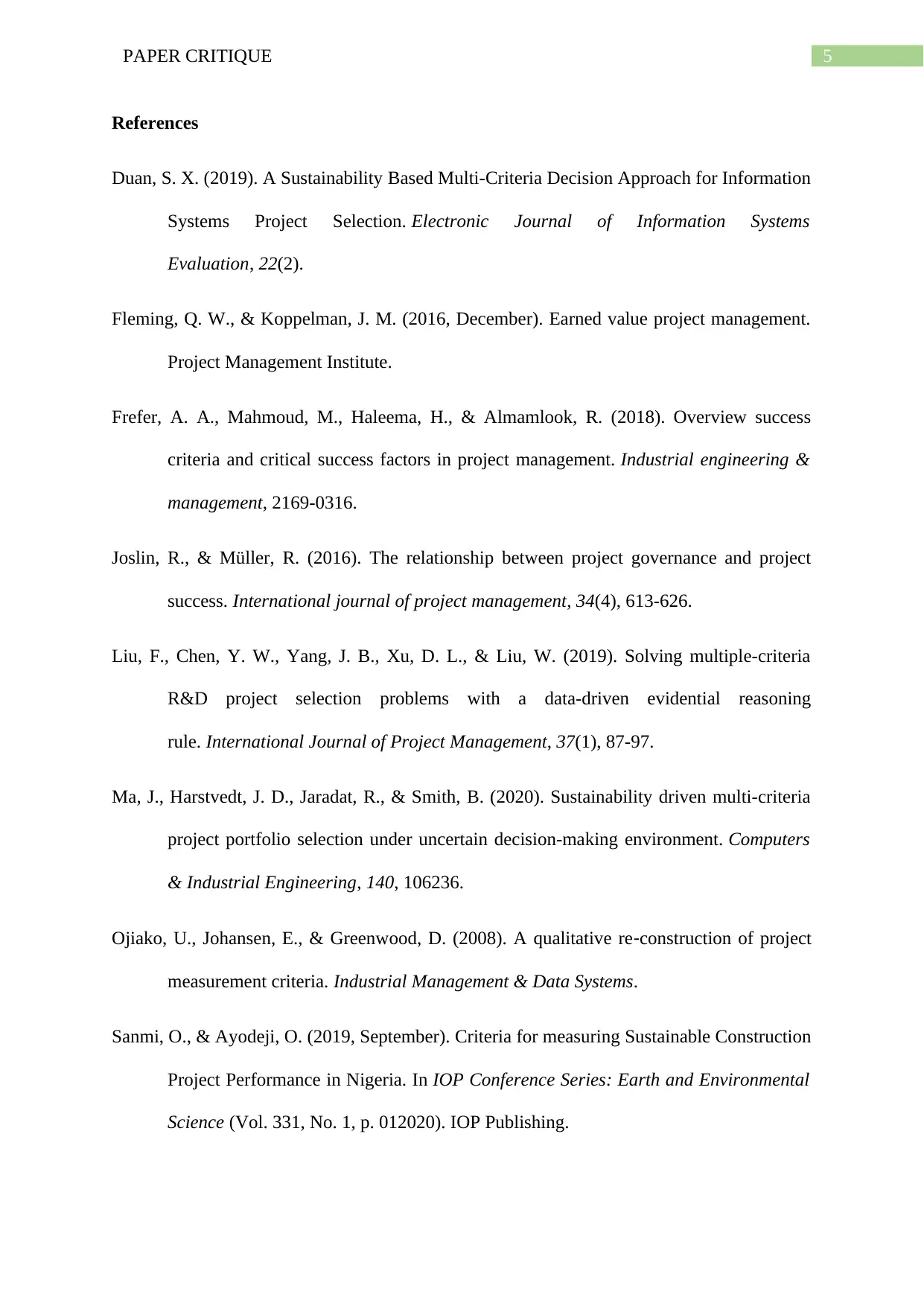
5PAPER CRITIQUE
References
Duan, S. X. (2019). A Sustainability Based Multi-Criteria Decision Approach for Information
Systems Project Selection. Electronic Journal of Information Systems
Evaluation, 22(2).
Fleming, Q. W., & Koppelman, J. M. (2016, December). Earned value project management.
Project Management Institute.
Frefer, A. A., Mahmoud, M., Haleema, H., & Almamlook, R. (2018). Overview success
criteria and critical success factors in project management. Industrial engineering &
management, 2169-0316.
Joslin, R., & Müller, R. (2016). The relationship between project governance and project
success. International journal of project management, 34(4), 613-626.
Liu, F., Chen, Y. W., Yang, J. B., Xu, D. L., & Liu, W. (2019). Solving multiple-criteria
R&D project selection problems with a data-driven evidential reasoning
rule. International Journal of Project Management, 37(1), 87-97.
Ma, J., Harstvedt, J. D., Jaradat, R., & Smith, B. (2020). Sustainability driven multi-criteria
project portfolio selection under uncertain decision-making environment. Computers
& Industrial Engineering, 140, 106236.
Ojiako, U., Johansen, E., & Greenwood, D. (2008). A qualitative re‐construction of project
measurement criteria. Industrial Management & Data Systems.
Sanmi, O., & Ayodeji, O. (2019, September). Criteria for measuring Sustainable Construction
Project Performance in Nigeria. In IOP Conference Series: Earth and Environmental
Science (Vol. 331, No. 1, p. 012020). IOP Publishing.
References
Duan, S. X. (2019). A Sustainability Based Multi-Criteria Decision Approach for Information
Systems Project Selection. Electronic Journal of Information Systems
Evaluation, 22(2).
Fleming, Q. W., & Koppelman, J. M. (2016, December). Earned value project management.
Project Management Institute.
Frefer, A. A., Mahmoud, M., Haleema, H., & Almamlook, R. (2018). Overview success
criteria and critical success factors in project management. Industrial engineering &
management, 2169-0316.
Joslin, R., & Müller, R. (2016). The relationship between project governance and project
success. International journal of project management, 34(4), 613-626.
Liu, F., Chen, Y. W., Yang, J. B., Xu, D. L., & Liu, W. (2019). Solving multiple-criteria
R&D project selection problems with a data-driven evidential reasoning
rule. International Journal of Project Management, 37(1), 87-97.
Ma, J., Harstvedt, J. D., Jaradat, R., & Smith, B. (2020). Sustainability driven multi-criteria
project portfolio selection under uncertain decision-making environment. Computers
& Industrial Engineering, 140, 106236.
Ojiako, U., Johansen, E., & Greenwood, D. (2008). A qualitative re‐construction of project
measurement criteria. Industrial Management & Data Systems.
Sanmi, O., & Ayodeji, O. (2019, September). Criteria for measuring Sustainable Construction
Project Performance in Nigeria. In IOP Conference Series: Earth and Environmental
Science (Vol. 331, No. 1, p. 012020). IOP Publishing.
⊘ This is a preview!⊘
Do you want full access?
Subscribe today to unlock all pages.

Trusted by 1+ million students worldwide
1 out of 6
Related Documents
Your All-in-One AI-Powered Toolkit for Academic Success.
+13062052269
info@desklib.com
Available 24*7 on WhatsApp / Email
![[object Object]](/_next/static/media/star-bottom.7253800d.svg)
Unlock your academic potential
Copyright © 2020–2025 A2Z Services. All Rights Reserved. Developed and managed by ZUCOL.




